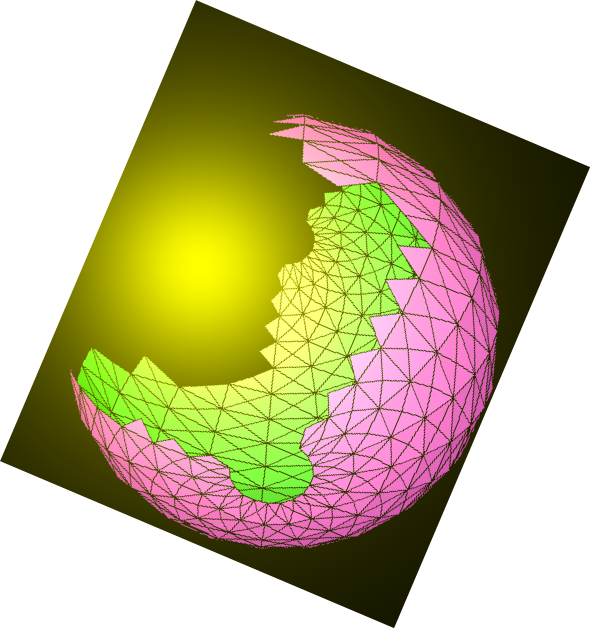
N.S.B. Cosmic Center

Literary Adventures
This page will take you into pieces of literature that are carefully selected for their great content at the literary, scientific, or philosophical level. A short selection will be presented in full. A long one will be divided into sections that will be refreshed regularly. Emphasis and highlights are mostly ours, not made by the original author.
Here is our current selection:
The Fairy-Land of Science (1878) by Arabella Burton Buckley
Lecture 6.
The Voices of Nature and How WE Hear Them
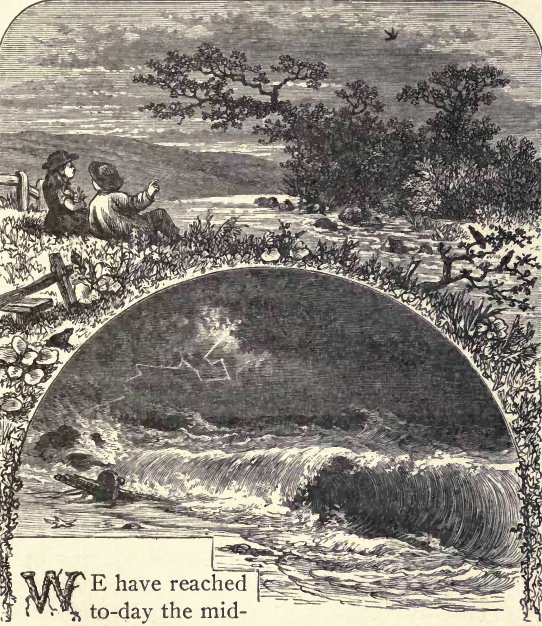
We have reached today the middle point of our course, and here we will make a new start. All the wonderful histories which we have been studying in the last five lectures have had little or nothing to do with living creatures. The sunbeams would strike on our earth, the air would move restlessly to and fro, the water-drops would rise and fall, the valleys and ravines would still be cut out by rivers, if there were no such thing as life upon the earth. But without living things there could be none of the beauty which these changes bring about. Without plants, the sunbeams, the air and the water would be quite unable to clothe the bare rocks, and without animals and man they could not produce light, or sound, or feeling of any kind.
In the next five lectures, however, we are going to learn something of the use living creatures make of the earth; and today we will begin by studying one of the ways in which
We are all so accustomed to trust to our sight to guide us in most of our actions, and to think of things as we see them, that we often forget how very much we owe to sound. And yet Nature speaks to us so much by her gentle, her touching, or her awful sounds, that the life of a deaf person is even more hard to bear than that of a blind one.
Have you ever amused yourself with trying how many different sounds you can distinguish if you listen at an open window in a busy street? You will probably be able to recognize easily the jolting of the heavy waggon or dray, the rumble of the omnibus, the smooth roll of the private carriage and the rattle of the light butcher's cart; and even while you are listening for these, the crack of the carter's whip, the cry of the costermonger at his stall, and the voices of the passers by will strike upon your ear. Then if you give still more close attention you will hear the doors open and shut along the street, the footsteps of the passengers, the scraping of the shovel of the mud-carts; nay, if he happen to stand near, you may even hear the jingling of the shoeblack's pence as he plays pitch and toss upon the pavement. If you think for a moment, does it not seem wonderful that you should hear all these sounds so that you can recognize each one distinctly while all the rest are going on around you?
But suppose you go into the quiet country. Surely there will be silence there. Try some day and prove it for yourself, lie down on the grass in a sheltered nook and listen attentively. If there be ever so little wind stirring you will hear it rustling gently through the trees; or even if there is not this, it will be strange if you do not hear some wandering gnat buzzing, or some busy bee humming as it moves from flower to flower. Then a grasshopper will set up a chirp within a few yards of you, or, if all living creatures are silent, a brook not far off may be flowing along with a rippling musical sound. These and a hundred other noises you will hear in the most quiet country spot; the lowing of cattle, the song of the birds, the squeak of the field-mouse, the croak of the frog, mingling with the sound of the woodman's axe in the distance, or the dash of some river torrent. And besides these quiet sounds, there are still other occasional voices of nature which speak to us from time to time. The howling of the tempestuous wind, the roar of the sea-waves in a storm, the crash of thunder, and the mighty noise of the falling avalanche; such sounds as these tell us how great and terrible nature can be.
Now, has it ever occurred to you to think what sound is, and how it is that we hear all these things? Strange as it may seem, if there were no creature that could hear upon the earth, there would be no such thing as sound, though all these movements in nature were going on just as they are now.
Try and grasp this thoroughly, for it is difficult at first to make people believe it. Suppose you were stone-deaf, there would be no such thing as sound to you. A heavy hammer falling on an anvil would indeed shake the air violently, but since this air when it reached your ear would find a useless instrument, it could not play upon it. And it is this play on the drum of your ear and the nerves within it speaking to your brain which makes sound. Therefore, if all creatures on or around the earth were without ears or nerves of hearing, there would be no instruments on which to play, and consequently there would be no such thing as sound. This proves that two things are needed in order that we may hear. First, the outside movement which plays on our hearing instrument; and, secondly, the hearing instrument itself.
First, then, let us try to understand what happens outside our ears. Take a poker and tie a piece of string to it, and holding the ends of the string to your ears, strike the poker against the fender. You will hear a very loud sound, for the blow will set all the particles of the poker quivering, and this movement will pass right along the string to the drum of your ear and play upon it.
Now take the string away from your ears, and hold it with your teeth. Stop your ears tight, and strike the poker once more against the fender. You will hear the sound quite as loudly and clearly as you did before, but this time the drum of your ear has not been agitated. How, then, has the sound been produced? In this case, the quivering movement has passed through your teeth into the bones of your head, and from them into the nerves, and so produced sound in your brain. And now, as a final experiment, fasten the string to the mantelpiece, and hit it again against the fender. How much feebler the sound is this time, and how much sooner it stops! Yet still it reaches you, for the movement has come this time across the air to the drum of your ear.
Here we are back again in the land of invisible workers! We have all been listening and hearing ever since we were babies, but have we ever made any picture to ourselves of how sound comes to us right across a room or a field, when we stand at one end and the person who calls is at the other?
Since we have studied the "aerial ocean," we know that the air filling the space between us, though invisible, is something very real, and now all we have to do is to understand exactly how the movement crosses this air.
This we shall do most readily by means of an experiment made by Dr. Tyndall in his lectures on Sound. I have here a number of boxwood balls resting in a wooden tray which has a bell hung at the end of it. I am going to take the end ball and roll it sharply against the rest, and then I want you to notice carefully what happens. See! the ball at the other end has flown off and hit the bell, so that you hear it ring. Yet the other balls remain where they were before. Why is this? It is
because each of the balls, as it was knocked forwards, had one in front of it to stop it and make it bound back again, but

Now imagine these balls to be atoms of air, and the bell your ear. If I clap my hands and so hit the air in front of them, each air-atom hits the next just as the balls did, and though it comes back to its place, it passes the shock on along the whole line to the atom touching the drum of your ear, and so you receive a blow. But a curious thing happens in the air which you cannot notice in the balls. You must remember that air is elastic, just as if there were springs between the atoms as in the diagram, Fig. 33, and so when any shock knocks the atoms forward, several of them can be crowded together before they push on those in front. Then, as soon as they have passed the shock on, they rebound and begin to separate again, and so swing to and fro till they come to rest. Meanwhile the second set will go through just the same movements, and will spring apart as soon as they have passed the shock on to a third set, and so you will have one set of crowded atoms and one set of separated atoms alternately all along the line, and the same set will never be crowded two instants together.

You may see an excellent example of this in a luggage train in a railway station, when the trucks are left to bump each other till they stop. You will see three or four trucks knock together, then they will pass the shock on to the four in front, while they themselves bound back and separate as far as their chains will let them: the next four trucks will do the same, and so a kind of wave of crowded trucks passes on to the end of the train, and they bump to and fro till the whole comes to a standstill. Try to imagine a movement like this going on in the line of air-atoms, Fig. 33, the drum of your ear being at the end B. Those which are crowded together at that end will hit on the drum of your ear and drive the membrane which covers it inwards; then instantly the wave will change, these atoms will bound back, and the membrane will recover itself again, but only to receive a second blow as the atoms are driven forwards again, and so the membrane will be driven in and out till the air has settled down.
This you see is quite different to the waves of light which move in crests and hollows. Indeed, it is not what we usually understand by a wave at all, but a set of crowdings and partings of the atoms of air which follow each other rapidly across the air. A crowding of atoms is called a condensation, and a parting is called a rarefaction, and when we speak of the length of a wave of sound, we mean the distance between two condensations, a a in Fig. 34, or between two rarefactions, b b.

Although each atom of air moves a very little way forwards and then back, yet, as a long row of atoms may be crowded together before they begin to part, a wave is often very long. When a man talks in an ordinary bass voice, he makes sound-waves from 8 to 12 feet long; a woman's voice makes shorter waves, from 2 to 4 feet long, and consequently the tone is higher, as we shall presently explain.
And now I hope that some one is anxious to ask why, when I clap my hands, anyone behind me or at the side, can hear it as well or nearly as well as you who are in front. This is because I give a shock to the air all round my hands, and waves go out on all sides, making as it were globes of crowdings and partings widening and widening away from the clap as circles widen on a pond. Thus the waves travel behind me, above me, and on all sides, until they hit the walls, the ceiling, and the floor of the room, and wherever you happen to be, they hit upon your ear.
If you can picture to yourself these waves spreading out in all directions, you will easily see why sound grows fainter at the distance. Just close round my hands when I clap them, there is a small quantity of air, and so the shock I give it is very violent, but as the sound-waves spread on all sides they have more and more air to move, and so the air-atoms are shaken less violently and strike with less force on your ear.
If we can prevent the sound-wave from spreading, then the sound is not weakened. The Frenchman Biot found that a low whisper could be heard distinctly for a distance of half a mile through a tube, because the waves could not spread beyond the small column of air. But unless you speak into a small space of some kind, you cannot prevent the waves going out from you in all directions.
Try and imagine that you see these waves spreading all round me now and hitting on your ears as they pass, then on the ears of those behind you, and on and on in widening globes till they reach the wall. What will happen when they get there? If the wall were thin, as a wooden partition is, they would shake it, and it again would shake the air on the other side, and so anyone in the next room would have the sound of my voice brought to their ear.
But something more will happen. In any case the sound-waves hitting against the wall will bound back from it just as a ball bounds back when thrown against anything, and so another set of sound-waves reflected from the wall will come back across the room. If these waves come to your ear so quickly that they mix with direct waves, they help to make the sound louder. For instance, if I say "Ha," you hear that sound louder in this room than you would in the open air, for the "Ha" from my mouth and a second "Ha" from the wall come to your ear so instantaneously that they make one sound. This is why you can often hear better at the far end of a church when you stand against a screen or a wall, than when you are half-way up the building nearer to the speaker, because near the wall the reflected waves strike strongly on your ear and make the sound louder.
Sometimes, when the sound comes from a great explosion, these reflected waves are so strong that they are able to break glass. In the explosion of gunpowder in St. John's Wood, many houses in the back streets had their windows broken; for the sound-waves bounded off at angles from the walls and struck back upon them.
Now, suppose the wall were so far behind you that the reflected sound-waves only hit upon your ear after those coming straight from me had died away; then you would hear the sound twice, "Ha" from me and "Ha" from the wall, and here you have an echo, "Ha, ha." In order for this to happen in ordinary air, you must be standing at least 56 feet away from the point from which the waves are reflected, for then the second blow will come one-tenth of a second after the first one, and that is long enough for you to feel them separately.[* Sound travels 1120 feet in a second, in air of ordinary temperature, and therefore 112 feet in the tenth of a second. Therefore the journey of 56 feet beyond you to reach the wall and 56 feet to return, will occupy the sound-wave one-tenth of a second and separate the two sounds.] Miss. C. A. Martineau tells a story of a dog which was terribly frightened by an echo. Thinking another dog was barking, he ran forward to meet him, and was very much astonished, when, as he came nearer the wall, the echo ceased. I myself once knew a case of this kind, and my dog, when he could find no enemy, ran back barking, till he was a certain distance off, and then the echo of course began again. He grew so furious at last that we had great difficulty in preventing him from flying at a strange man who happened to be passing at the time.
Sometimes, in the mountains, walls of rock rise at some distance one behind another, and then each one will send back its echo a little later than the rock before it, so that the "Ha" which you give will come back as a peal of laughter. There is an echo in Woodstock Park which repeats the word twenty times. Again sometimes, as in the Alps, the sound-waves in coming back rebound from mountain to mountain and are driven backwards and forwards, becoming fainter and fainter till they die away; these echoes are very beautiful.
If you are now able to picture to yourselves one set of waves going to the wall, and another set returning and crossing them, you will be ready to understand something of that very difficult question. How is it that we can hear many different sounds at one time and tell them apart?
Have you ever watched the sea when its surface is much ruffled, and noticed how, besides the big waves of the tide, there are numberless smaller ripples made by the wind blowing the surface of the water, or the oars of a boat dipping in it, or even rain-drops falling? If you have done this you will have seen that all these waves and ripples cross each other, and you can follow any one ripple with your eye as it goes on its way undisturbed by the rest. Or you may make beautiful crossing and recrossing ripples on a pond by throwing in two stones at a little distance from each other, and here too you can follow any one wave on to the edge of the pond.
Now just in this way the waves of sound, in their manner of moving, cross and recross each other. You will remember too, that different sounds make waves of different lengths, just as the tide makes a long wave and the rain-drops tiny ones. Therefore each sound falls with its own peculiar wave upon your ear, and you can listen to that particular wave just as you look at one particular ripple, and then the sound becomes clear to you.
All this is what is going on outside your ear, but what is happening in your ear itself? How do these blows of the air speak to your brain? By means of the following diagram, Fig. 35, we will try to understand roughly our beautiful hearing instrument, the ear.
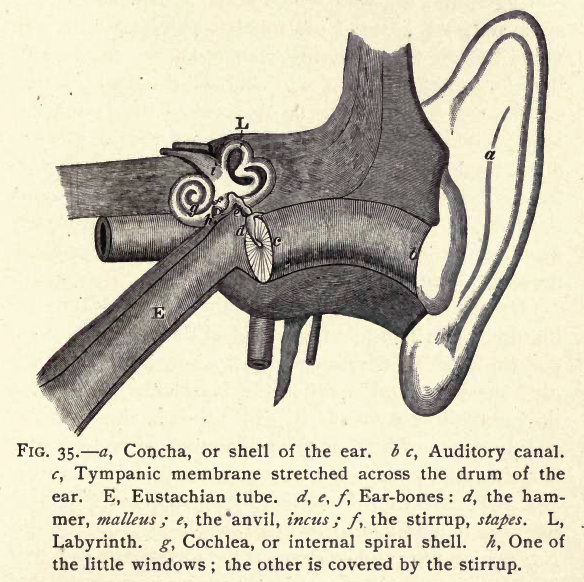
First, I want you to notice how beautifully the outside shell, or concha as it is called (a), is curved round so that any movement of the air coming to it from the front is caught in it and reflected into the hole of the ear. Put your finger round your ear and feel how the gristly part is curved towards the front of your head. This concha makes a curve much like the curve a deaf man makes with his hand behind his ear to catch the sound. Animals often have to raise their ears to catch the sound well, but ours stand always ready. When the air-waves have passed in at the hole of your ear, they move all the air in the passage, b c, which is called the auditory, or hearing, canal. This canal is lined with little hairs to keep out insects and dust, and the wax which collects in it serves the same purpose. But if too much wax collects, it prevents the air from playing well upon the drum, and therefore makes you deaf. Across the end of this canal, at c, a membrane or skin called the tympanum is stretched, like the parchment over the head of a drum, and it is this membrane which moves to and fro as the air-waves strike on it. A violent box on the ear will sometimes break this delicate membrane, or injure it, and therefore it is very wrong to hit a person violently on the ear.
On the other side of this membrane, inside the ear, there is air, which fills the whole of the inner chamber and the tube E, which runs down into the throat behind the nose, and is called the Eustachian tube after the man who discovered it. This tube is closed at the end by a valve which opens and shuts. If you breathe out strongly, and then shut your mouth and swallow, you will hear a little "click" in your ear. This is because in swallowing you draw the air out of the Eustachian tube and so draw in the membrane c, which clicks as it goes back again. But unless you do this the tube and the whole chamber cavity behind the membrane remains full of air.
Now, as this membrane is driven to and fro by the sound-waves, it naturally shakes the air in the cavity behind it, and it also sets moving three most curious little bones. The first of these bones d is fastened to the middle of the drumhead so that it moves to and fro every time this membrane quivers. The head of this bone fits into a hole in the next bone e, the anvil, and is fastened to it by muscles, so as to drag it along with it; but, the muscles being elastic, it can draw back a little from the anvil, and so give it a blow each time it comes back. This anvil, e is in its turn very firmly fixed to the little bone f, shaped like a stirrup, which you see at the end of the chain.
This stirrup rests upon a curious body L, which looks in the diagram like a snail-shell with tubes coming out of it. This body, which is called the labyrinth, is made of bone, but it has two little windows in it, one h covered only by a membrane, while the other has the head of the stirrup f resting upon it.
Now, with a little attention you will understand that when the air in the canal b c shakes the drumhead c to and fro, this membrane must drag with it the hammer, the anvil, and the stirrup. Each time the drum goes in, the hammer will hit the anvil, and drive the stirrup against the little window; every time it goes out it will draw the hammer, the anvil, and the stirrup out again, ready for another blow. Thus the stirrup is always playing upon this little window. Meanwhile, inside the bony labyrinth L there is a fluid like water, and along the little passages are very fine hairs, which wave to and fro like reeds; and whenever the stirrup hits at the little window, the fluid moves these hairs to and fro, and they irritate the ends of a nerve i, and this nerve carries the message to your brain. There are also some curious little stones called otoliths, lying in some parts of this fluid, and they, by their rolling to and fro, probably keep up the motion and prolong the sound.
You must not imagine we have explained here the many intricacies which occur in the ear; I can only hope to give you a rough idea of it, so that you may picture to yourselves the air-waves moving backwards and forward in the canal of your ear, then the tympanum vibrating to and fro, the hammer hitting the anvil, the stirrup knocking at the little window, the fluid waving the fine hairs and rolling the tiny stones, the ends of the nerve quivering, and then (how we know not) the brain hearing the message.
Is not this wonderful, going on as it does at every sound you hear? And yet this is not all, for inside that curled part of the labyrinth g, which looks like a snail-shell and is called the cochlea, there is a most wonderful apparatus of more than three thousand fine stretched filaments or threads, and these act like the strings of a harp, and make you hear different tones. If you go near to a harp or a piano, and sing any particular note very loudly, you will hear this note sounding in the instrument, because you will set just that particular string quivering, which gives the note you sang. The air-waves set going by your voice touch that string, because it can quiver in time with them, while none of the other strings can do so. Now, just in the same way the tiny instrument of three thousand strings in your ear, which is called Corti's organ, vibrates to the air-waves, one thread to one set of waves, and another to another, and according to the fibre that quivers, will be the sound you hear. Here then at last, we see how nature speaks to us. All the movements going on outside, however violent and varied they may be, cannot of themselves make sound. But here, in the little space behind the drum of our ear, the air-waves are sorted and sent on to our brain, where they speak to us as sound.
But why then do we not hear all sounds as music? Why are some mere noise, and others clear musical notes? This depends entirely upon whether the sound-waves come quickly and regularly, or by an irregular succession of shocks. For example, when a load of stones is being shot out of a cart, you hear only a long continuous noise, because the stones fall irregularly, some quicker, some slower, here a number together, and there two or three stragglers by themselves; each of these different shocks comes to your ear and makes a confused, noisy sound. But if you run a stick very quickly along a paling, you will hear a sound very like a musical note. This is because the rods of the paling are all at equal distances one from the other, and so the shocks fall quickly one after another at regular intervals upon your ear. Any quick and regular succession of sounds makes a note, even though it may be an ugly one. The squeak of a slate pencil along a slate, and the shriek of a railway whistle are not pleasant, but they are real notes which you could copy on a violin.
I have here a simple apparatus which I have had made to show you that rapid and regular shocks produce a natural musical note. This wheel (Fig. 36) is milled at the edge like a shilling, and when I turn it rapidly so that it strikes against the edge of the card fixed behind it, the notches strike in rapid succession, and produce a musical sound. We can also prove by this experiment that the quicker the blows are, the higher the note will be. I pull the string gently at first, and then quicker and quicker, and you will notice that the note grows sharper and sharper, till the movement begins to slacken, when the note goes down again. This is because the more rapidly the air is hit, the shorter are the waves it makes, and short waves give a high note.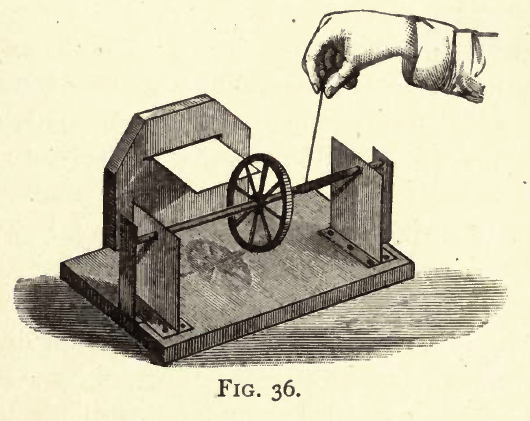
Let us examine this with two tuning-forks. I strike one, and it sounds C, the third space in the treble; I strike the other, and it sounds A, the first leger line, five notes above the C. I have drawn on this diagram (Fig. 37), an imaginary picture of these two sets of waves. You see that the A fork makes three waves, while the C fork makes only two. Why is this? Because the prong of the A fork moves three times backwards and forwards while the prong of the C fork only moves twice; therefore the A fork does not crowd so many atoms together before it draws back, and the waves are shorter. These two notes, C and A, are a fifth apart; if we had two forks, of which one went twice as fast as the other, making four waves while the other made two, then the notes of these forks would be an octave higher.
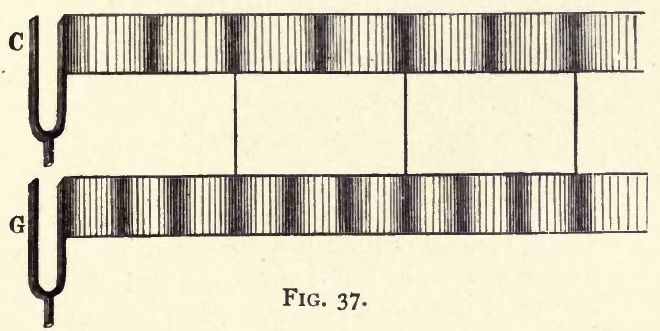
So we see that all the sounds we hear,--the warning noises which keep us from harm, the beautiful musical notes with all the tunes and harmonies that delight us, even the power of hearing the voices of those we love, and learning from one another that which each can tell,--all these depend upon the invisible waves of air, even as the pleasures of light depend on the waves of ether. It is by these sound-waves that nature speaks to us, and in all her movements there is a reason why her voice is sharp or tender, loud or gentle, awful or loving. Take for instance the brook we spoke of at the beginning of the lecture. Why does it sing so sweetly, while the wide deep river makes no noise? Because the little brook eddies and purls round the stones, hitting them as it passes; sometimes the water falls down a large stone, and strikes against the water below; or sometimes it grates the little pebbles together as they lie in its bed. Each of these blows makes a small globe of sound-waves, which spread and spread till they fall on your ear, and because they fall quickly and regularly, they make a low, musical note. We might almost fancy that the brook wished to show how joyfully it flows along, recalling Shelley's beautiful lines:--
"Sometimes it fell
Among the moss with hollow harmony,
Dark and profound; now on the polished stones
It danced: like childhood laughing as it went."
The broad deep river, on the contrary, makes none of these cascades and commotions. The only places against which it rubs are the banks and the bottom; and here you can sometimes hear it grating the particles of sand against each other if you listen very carefully. But there is another reason why falling water makes a sound, and often even a loud roaring noise in the cataract and in the breaking waves of the sea. You do not only hear the water dashing against the rocky ledges or on the beach, you also hear the bursting of innumerable little bladders of air which are contained in the water. As each of these bladders is dashed on the ground, it explodes and sends sound-waves to your ear. Listen to the sea some day when the waves are high and stormy, and you cannot fail to be struck by the irregular bursts of sound.
The waves, however, do not only roar as they dash on the ground; have you never noticed how they seem to scream as they draw back down the beach? Tennyson calls it,
"The scream of the madden'd beach dragged down by the wave;"
and it is caused by the stones grating against each other as the waves drag them down. Dr. Tyndall tells us that it is possible to know the size of the stones by the kind of noise they make. If they are large, it is a confused noise; when smaller, a kind of scream; while a gravelly beach will produce a mere hiss.
Who could be dull by the side of a brook, a waterfall, or the sea, while he can listen for sounds like these, and picture to himself how they are being made? You may discover a number of other causes of sound made by water, if you once pay attention to them.
Nor is it only water that sings to us. Listen to the wind, how sweetly it sighs among the leaves. There we hear it, because it rubs the leaves together, and they produce the sound-waves. But walk against the wind some day and you can hear it whistling in your own ear, striking against the curved cup, and then setting up a succession of waves in the hearing canal of the ear itself.
Why should it sound in one particular tone when all kinds of sound-waves must be surging about in the disturbed air?
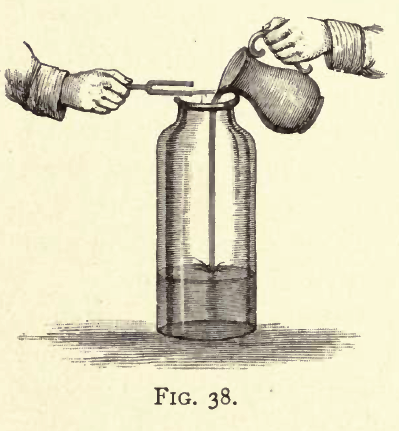
This glass jar will answer our question roughly. If I strike my tuning-fork and hold it over the jar, you cannot hear it, because the sound is feeble, but if I fill the jar gently with water, when the water rises to a certain point you will hear a loud clear note, because the waves of air in the jar are exactly the right length to answer to the note of the fork. If I now blow across the mouth of the jar you hear the same note, showing that a cavity of a particular length will only sound to the waves which fit it. Do you see now the reason why pan-pipes give different sounds, or even the hole at the end of a common key when you blow across it? Here is a subject you will find very interesting if you will read about it, for I can only just suggest it to you here. But now you will see that the canal of your ear also answers only to certain waves, and so the wind sings in your ear with a real if not a musical note.
Again, on a windy night have you not heard the wind sounding a wild, sad note down a valley? Why do you think it sounds so much louder and more musical here than when it is blowing across the plain? Because the air in the valley will only answer to a certain set of waves, and, like the pan-pipe, gives a particular note as the wind blows across it, and these waves go up and down the valley in regular pulses, making a wild howl. You may hear the same in the chimney, or in the keyhole; all these are waves set up in the hole across which the wind blows. Even the music in the shell which you hold to your ear is made by the air in the shell pulsating to and fro. And how do you think it is set going? By the throbbing of the veins in your own ear, which causes the air in the shell to vibrate.
Another grand voice of nature is the thunder. People often have a vague idea that thunder is produced by the clouds knocking together, which is very absurd, if you remember that clouds are but water-dust. The most probable explanation of thunder is much more beautiful than this. You will remember from Lecture III. that heat forces the air-atoms apart. Now, when a flash of lightning crosses the sky it suddenly expands the air all round it as it passes, so that globe after globe of sound-waves is formed at every point across which the lightning travels. Now light, you remember, travels so wonderfully rapidly (192,000 miles in a second) that a flash of lightning is seen by us and is over in a second, even when it is two or three miles long. But sound comes slowly, taking five seconds to travel a mile, and so all the sound-waves at each point of the two or three miles fall on our ear one after the other, and make the rolling thunder. Sometimes the roll is made even longer by the echo, as the sound-waves are reflected to and fro by the clouds on their road; and in the mountains we know how the peals echo and re-echo till they die away.
We might fill up far more than an hour in speaking of those voices which come to us as nature is at work. Think of the patter of the rain, how each drop as it hits the pavement sends circles of sound-waves out on all sides; or the loud report which falls on the ear of the Alpine traveller as the glacier cracks on its way down the valley; or the mighty boom of the avalanche as the snow slides in huge masses off the side of the lofty mountain. Each and all of these create their sound-waves, large or small, loud or feeble, which make their way to your ear, and become converted into sound.
We have, however, only time now just to glance at life-sounds, of which there are so many around us. Do you know why we hear a buzzing, as the gnat, the bee, or the cockchafer fly past? Not by the beating of their wings against the air, as many people imagine, and as is really the case with humming birds, but by the scraping of the under-part of their hard wings against the edges of their hind-legs, which are toothed like a saw. The more rapidly their wings move the stronger the grating sound becomes, and you will now see why in hot, thirsty weather the buzzing of the gnat is so loud, for the more thirsty and the more eager he becomes, the wilder his movements will be.
Some insects, like the drone-fly (Eristalis tenax), force the air through the tiny air-passages in their sides, and as these passages are closed by little plates, the plates vibrate to and fro and make sound-waves. Again, what are those curious sounds you may hear sometimes if you rest your head on a trunk in the forest? They are made by the timber-boring beetles, which saw the wood with their jaws and make a noise in the world, even though they have no voice.
All these life-sounds are made by creatures which do not sing or speak; but the sweetest sounds of all in the woods are the voices of the birds. All voice-sounds are made by two elastic bands or cushions, called vocal chords, stretched across the end of the tube or windpipe through which we breathe, and as we send the air through them we tighten or loosen them as we will, and so make them vibrate quickly or slowly and make sound-waves of different lengths. But if you will try some day in the woods you will find that a bird can beat you over and over again in the length of his note; when you are out of breath and forced to stop he will go on with his merry trill as fresh and clear as if he had only just begun. This is because birds can draw air into the whole of their body, and they have a large stock laid up in the folds of their windpipe, and besides this the air-chamber behind their elastic bands or vocal chords has two compartments where we have only one, and the second compartment has special muscles by which they can open and shut it, and so prolong the trill.
Only think what a rapid succession of waves must quiver through the air as a tiny lark agitates his little throat and pours forth a volume of song! The next time you are in the country in the spring, spend half an hour listening to him, and try and picture to yourself how that little being is moving all the atmosphere round him. Then dream for a little while about sound, what it is, how marvellously it works outside in the world, and inside in your ear and brain; and then, when you go back to work again, you will hardly deny that it is well worth while to listen sometimes to the voices of nature and ponder how it is that we hear them.

Home
N.S.B. Cosmic Center
